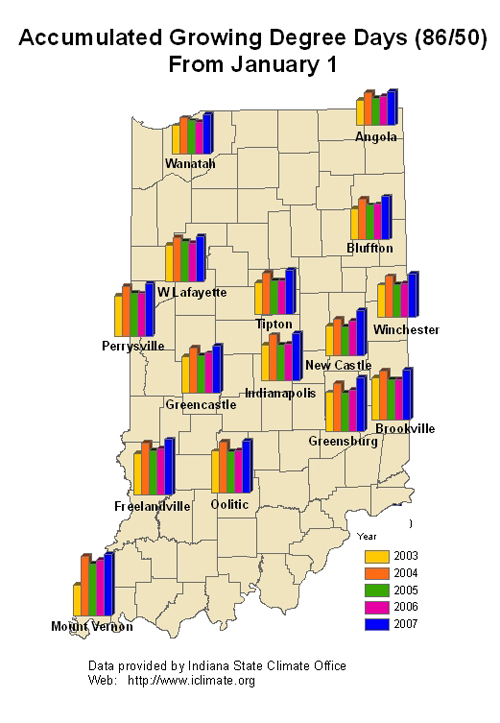Pest & Crop Newsletter, Entomology Extension, Purdue University
- Morningglory Control in Roundup Ready/Glyphosate Tolerant Corn
- ALS-Resistant Ragweed Control in Non GMO Soybeans
- Field-Edge Weed Control Prevents Future Problems
- Got Residual?
![]()
A New Field Crops Pest for Indiana: Asiatic Garden Beetle – (Christian Krupke, John Obermeyer, and Larry Bledsoe)
- Adults were found in a few northern counties last year.
- Primarily a turf and garden pest, this is the first report of larval feeding on corn.
- Check suspected grub damage and get an ID - especially in northern counties.
A visit to a suspected grub damaged first-year, no-till corn field (previously soybean) in Elkhart County yielded some unexpected findings last week. Gary Kaufman and Brian Willard of Crop Tech Consulting were finding widespread damage to corn grown in sandy soils in the northern parts of the county. Upon examination and referring to pest identification keys, the small white grubs doing the mesocotyl and root feeding did not look quite like any of those listed in the IPM manuals. After taking them back to the lab we soon found out why - these were not a known corn pest. The grubs in question were Asiatic Garden Beetle larvae.

Christian Krupke in grub infested field of Asiatic garden beetle (Photo credit: John Obermeyer)
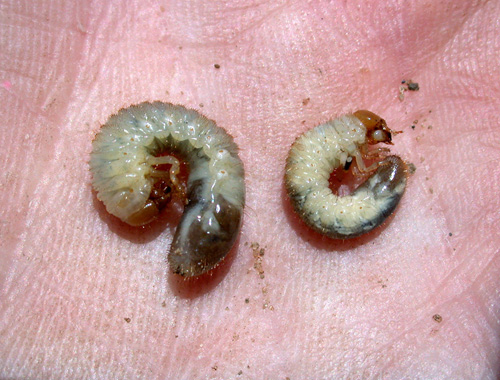
Size comparison of mature grubs of Japanese beetle (left) and Asiatic garden beetle (right)
(Photo credit: John Obermeyer)
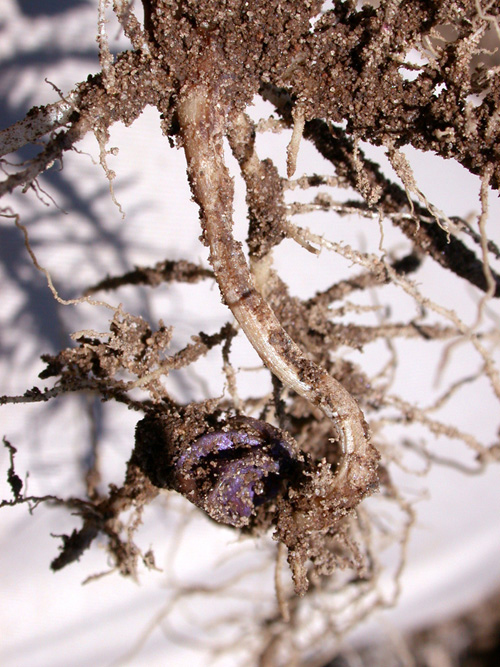
Damaged mesocotyl of dying plant (Photo credit: John Obermeyer)

Asiatic garden grub (Photo credit: John Obermeyer)
The Asiatic garden beetle was introduced to the US in the 1920’s on the east coast and have gradually made their way across the country. Adults were found in light traps in St. Joseph, Porter, and Allen Counties late in 2006, but this year’s larval damage was only expected in turf, ornamental, and/or vegetable plants. It’s become fairly obvious the grubs have acquired a taste for corn, as we saw relatively high densities in limited sampling. The corn seed in question was protected with Poncho 250, and, in some cases Poncho 1250. Feeding damage was evident on both treatments. The grubs will feed for another 2 weeks or so before pupating. From approximately mid-July through mid-August, adult beetles will feed, mate, and lay eggs that give rise to larvae that overwinter for next season. We intend to confirm Asiatic garden beetle feeding on soybean this summer. Overall, this insect and its habits are quite similar to Japanese beetle. However, we did not even have this one on our watch list and it is a surprise to find it feeding in corn.
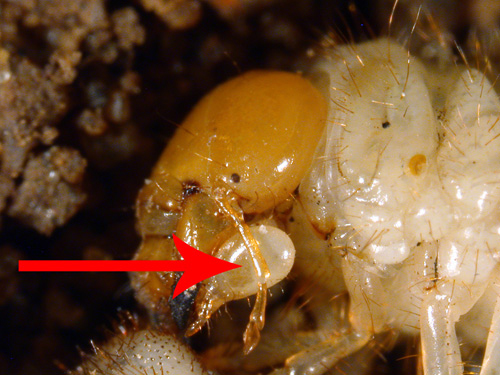
A key characteristic of the Asiatic garden beetle grub, enlarged maxillary palps (Photo credit: John Obermeyer)

Raster pattern of Asiatic garden beetle grub (Photo credit: John Obermeyer)

Raster pattern of Japanese beetle grub (Photo credit: John Obermeyer)
What this means is that we have another pest to keep an eye on. For now, we would urge anyone (especially those in northern counties) that has fields with suspected grub damage to get a positive identification of the grub causing the problems. The accompanying photos should aid you in making a diagnosis. Please contact us if you suspect you have these grubs in your field - at this point we are hoping to document the range of this new pest. We will be using a network of light traps to monitor this and other invasive and “new” pests in the adult stage later this summer. For more information on the Asiatic garden beetle visit the "Indiana's Most Unwanted Invasive Plant Pests" website <http://www.entm.purdue.edu/CAPS/pestInfo/asiaticGardenbtl.htm>. Stay tuned, and happy scouting!
![]()
Soybean Aphid Continues to Be Found – (Christian Krupke, John Obermeyer, and Larry Bledsoe)
- Soybean aphid reproducing on soybean in northern Indiana.
- Many beneficials impacting populations.
- Begin scouting soon to know which fields to watch.
Soybean aphid continues to be found in northern Indiana soybean fields, and reports from throughout the Midwest (including Wisconsin, Michigan, and Ohio last week) tell a similar story. All signs still point to an “aphid year” in 2007. The good news is that predator and parasite populations are able to keep pace with SBA early in the season, and there is no cause for alarm yet. However, it is advisable to get out and see what is happening in your fields sooner than later. Case in point, a producer in St. Joseph County has noticed a dramatic decline in populations within the last week due to the impact of beneficial insects. He is now convinced that adding insecticide to the soon-to-be-applied glyphosate would be a huge mistake.
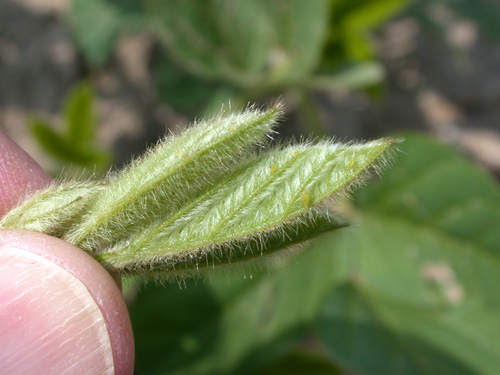
Soybean aphids on new growth, look carefully!
A reminder that the soybean aphid monitoring platform, <http://www.sbrusa.net> is up and running and is a valuable resource for both aphid and rust movement updates.
![]() VIDEO: Watch a video taken May 31, in St. Joseph County, documenting the soybean aphid colonizing plants and multiple beneficial insects feeding upon them.
VIDEO: Watch a video taken May 31, in St. Joseph County, documenting the soybean aphid colonizing plants and multiple beneficial insects feeding upon them.
![]()
Click here to view the
Black Light Trap Catch Report - (John Obermeyer)
Morningglory Control in Roundup Ready/Glyphosate Tolerant Corn – (Bill Johnson)
It is common knowledge that morningglories are tough to control with many postemergence herbicides, including glyphosate. Morningglory control in corn appears to have become more problematic over the last couple of years due to reduced use of soil residual herbicides and the fact that it is a weed that emerges relatively late in the spring after soil residual herbicides have dissipated. Atrazine provides effective control of morningglories as a pre or postemergence herbicide. As adoption of Roundup Ready/Glyphosate Tolerant corn increases, it appears that growers have reduced reliance on soil applied atrazine premix herbicides.
The best options for controlling morningglories postemergence in corn will depend on the following factors: 1) corn size/growth stage, 2) morningglory size, 3) whether or not glyphosate is needed as a tankmix partner.
If glyphosate is needed as a tankmix partner for other weeds, corn is 12 inches or less in height and morningglories are small (runners less than 4 inches), tank mix atrazine at 0.75 to 1.25 lb ai/A and increase glyphosate rate to 1.125 lb ae/A. This treatment will also provide some residual activity for later emerging flushes of morningglory. Another approach for this scenario would be to use dicamba, Distinct or Status with glyphosate. However, the use of atrazine will result in more residual control of the morningglories
If glyphosate is needed as a tankmix partner for other weeds and corn is more than 12 inches tall, the best option would be to use Distinct or Status tankmixed with glyphosate. The maximum labeled rate of Distinct is 4 oz/A on 10 to 24 inch tall corn. The most common use rate in a tankmix with glyphosate is 2 to 3 oz/A. Status can be used at rates of 2.5 to 10 oz/A on corn up to 36 inches tall (V10). The most common rate used in a tankmix with glyphosate is 5 oz/A.
If glyphosate is not needed as a tankmix partner and corn is more than 12 inches tall, consider the use of bromoxynil. It can be used up until tassel emergence at rates of 1 to 1.5 pt/A. Since bromoxynil is a contact herbicide, effective coverage is important, so apply in at least 10 GPA carrier volume and use flat fan spray nozzles with 30 psi of pressure at the spray boom.
![]()
ALS-Resistant Ragweed Control in Non GMO Soybeans - (Mark Loux, Ohio State University)
Common and giant ragweed populations are likely to be resistant to ALS inhibitors in many nonGMO soybean fields Resistant plants will not be controlled by postemergence ALS inhibitors, including Classic, FirstRate, Synchrony, Pursuit, and Raptor Many non GMO producers apply postemergence treatments consisting of an ALS inhibitor plus a PPO inhibitor (Flexstar, Cobra, or Phoenix) It’s important to recognize that, where ALS resistance is known or suspected, full rates of the Flexstar, Cobra, or Phoenix should be used in these combinations to ensure most effective control of resistant plants The ALS inhibitor in the mixture can control other weeds in the field, and can help control ragweed that are not ALS–resistant, but will not provide any control of resistant plants Adjuvant selection should also be geared to maximize the activity of the PPO inhibitor
It is possible that fields with ALS-resistant giant ragweed may require a second postemergence application of a PPO inhibitor, to control late-emerging plants and plants that were not completely killed by the first application Making two postemergence applications is a more effective strategy than delaying the initial application until giant ragweed are large, which can reduce PPO inhibitor effectiveness Where two applications of PPO inhibitors are likely to be necessary, we suggest use of Flexstar in the first application, followed by Cobra or Phoenix in the second application Due to its persistence in soil and possibility (though slim) of carryover to corn, Flexstar can only be applied once per season, and early-season application helps minimize the risk of carryover The short soil life of lactofen, the active ingredient in Cobra and Phoenix, ensures that carryover is not a possibility even with late-season applications.
![]()
Field-Edge Weed Control Prevents Future Problems - (Mark LouxOhio State University)
This is just a reminder of the importance of prevention in weed management programs Many biennial and perennial weed problems spread into crop fields from adjoining fencerows, roadsides, ditchbanks, and the edges of woods Application of herbicide to weeds in these areas at this time of the year can provide effective control and prevent seed production, limiting their spread Herbicides that have utility for noncrop areas include Crossbow, glyphosate, Cimarron, and mixtures of 2,4-D + dicamba, among others Similarly, paying extra attention to the weed control in the first 20 feet or so of crop fields that adjoin fencerows and similar areas can prevent small infestations from turning into major problems “Extra attention” to the edges of crop fields might entail use of higher glyphosate rates, making a second sprayer pass around the field later in the season to ensure control of giant ragweed and perennials, removing individual plants by hand, and cutting plants off at the surface and treating the cut area with herbicide
![]()
Got Residual? - (Mark LouxOhio State University)
About this time of the season, the crop should start to become an essential component of the weed management program in a field Healthy and uniform crop development, and the resulting shading of the soil surface, helps ensure that late-emerging weeds are suppressed and unable to effectively compete with the crop For example, our research shows that when postemergence herbicides are applied to corn that is about 14 inches or taller, there should be little need for residual herbicide activity due to the corn’s ability to suppress later-emerging weeds In contrast, we have often observed problems with poor control of weeds that emerge after early postemergence, non-residual treatments applied when corn is less than 10 inches tall This can even occur where residual herbicides were applied at planting, because applying postemergence herbicides to very small corn fails to take advantage of the full utility of a two-application herbicide system
As a result of unfavorable growing conditions over the past month, there can be quite a range in the size and growth stage of the crop within fields, from plants that have just emerged to plants that are relatively large Weed size dictates that many fields should be treated with postemergence herbicides at this time, but the crop may not be well developed enough, or uniformly large enough, to do its part for weed control One solution to this problem is to apply postemergence herbicides now, and then again in several weeks to control late-emerging weeds This approach makes the most sense in Roundup Ready crops, since it can be accomplished relatively inexpensively and late glyphosate applications should not injure the crop Aside from the major disadvantage of over-reliance on glyphosate, the other disadvantage of this approach in corn is that the second application can be difficult to apply when the crop is large
The second approach to the problem of an uneven crop is to include herbicides with residual activity in postemergence treatments, with the goal of having the residual herbicides control weeds until the smallest crop plants are large enough to help out Herbicides with residual activity that can be added to postemergence glyphosate applications in soybeans include the following:
Scepter – residual control of broadleaf weeds, including black nightshade and giant ragweed (except ALS-resistant) Very little residual control of grasses.
Pursuit – residual control of grass and broadleaf weeds, but not as effective as Scepter on ragweeds, cocklebur, or morningglory Extreme is a premix of glyphosate plus Pursuit.
FirstRate – residual control of many broadleaf weeds, but not black nightshade No residual grass control Use a rate of at least 0.3 oz/A.
Classic/Synchrony – potential for residual activity on broadleaf weeds, although the rate of chlorimuron is too low to ensure effective control of more tolerant species No residual grass control.
Flexstar – potential for residual activity on pigweed, waterhemp, morningglories, common ragweed No residual grass control.
In corn, the following herbicides have postemergence and residual activity, depending upon rate applied:
Atrazine – residual control of broadleaf weeds Suppresses or controls annual grasses (except fall panicum), but primarily at higher rates Any treatment or product containing atrazine must be applied when the corn is less than 12 inches tall.
Atrazine/acetamide premix products (Bicep II Magnum, Harness Xtra, Guardsman Max, etc.) – residual control of grass and broadleaf weeds Maximum corn size for postemergence application ranges from 5 to 11 inches, depending upon product.
Callisto – residual control of broadleaf weeds No residual control of grasses, with the possible exception of large crabgrass.
Hornet – residual control of broadleaf weeds No residual control of grasses.
Impact – residual control of some broadleaf weeds.
Resolve – residual control of annual grasses and a few broadleaf weeds, including lambsquarters, pigweeds, smartweeds, and common ragweed Maximum corn size of 12 inches.
Lightning (Clearfield corn only) – residual control of annual grass and broadleaf weeds.

